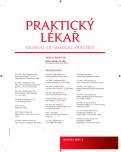Pseudotumor cerebri
Authors:
N. Vinakurau 1; E. Ehler 1; M. Kanta 2
Authors‘ workplace:
Pardubická krajská nemocnice a. s. Neurologická klinikaPřednosta: doc. MUDr. Edvard Ehler, CSc.
1; Neurochirurgická klinika fakultní nemocnice Hradec KrálovéPřednosta: prof. MUDr. Svatopluk Řehák, CSc.
2
Published in:
Prakt. Lék. 2015; 95(2): 83-85
Category:
Case Report
Overview
The authors present two clinical cases of young women with pseudotumor cerebri, which manifested with a tension headache and transient visual disturbance. Normal findings on the neurological examination and the unspecified imaging findings were found in both cases. Optic disc edemas were found in both patients and subsequent lumbar puncture revealed intracranial hypertension. The symptoms and findings on the fundus oculi progressed despite of complex conservative therapy and repeated lumbar puncture. Ventriculoperitoneal shunt was inserted to both patients with improving of visual disturbances and stabilization of condition.
Keywords:
pseudotumor cerebri – intracranial pressure – lumbar puncture
Sources
1. Ahmed RM, Wilkinson M, Parker GD. Transverse sinus stenting for idio-pathic intracranial hypertension: a review of 52 patients and of modelpredictions. Am J Neuroradiol 2011; 32(8): 1408–1414.
2. Banta JT, Farris BK. Pseudotumor cerebri and optic nerve sheath decompression. Ophthalmology 2000; 107(10): 1907–1912.
3. Bicakci K, Bicakci S, Aksungur E. Perfusion and diffusionmagnetic resonance imaging in idiopathic intracranial hypertension. Acta Neurol Scand 2006; 114: 193–197.
4. Dandy WE. Intracranial pressure without brain tumor, diagnosis and treatment. Ann Surg 1937; 106(4): 492–513
5. Farb RI, Vanek I, Scott JN. Idiopathic intracranial hypertension: the prevalence and morfology of sinovenous stenosis. Neurology 2003; 60(9): 1418–1424.
6. Friedman DI, Jacobson DM. Diagnostic kriteria for idiopathic intracranial hypertension Neurology 2002; 59(10): 1492–1495.
7. Garton HJ. Cerebrospinal fluid diversion procedures. J Neuroophthalmol 2004; 24(2): 146–155.
8. Kang S. Efficacy of lumbo-peritoneal versus ventriculoperitoneal shunting for management of chronic hydrocefalus following aneurismal subarachnoid hemorrhage. Acta Neurochirurgica (Wien) 2000; 142: 45–49.
9. Liguori C, Romigi A, Albanese M. Revised diagnostic kriteria for the pseudotumor cerebri syndrome in adults and children. Neurology 2014; 82(19): 1752–1753.
10. Lampl L, Eshel Y, Kesslerataut A. Serum leptin level in womenwith IIH. J Neurol Neurosurg Psychiatry 2002; 72(5): 642–643.
11. Spennato P, Ruggiero C, Parlato RF. Pseudotumor cerebri. Childs Nerv Syst 2011; 27: 215–235.
12. Sedláček K, Keller O. Benigní intrakraniální hypertenze. Novinky v oftalmologii 1999; 8: 11–14.
13. Vladyková J, Machová H, Cigánek L. Prognóza u mozkových pseudotumorů. Čs. Oftal. 1982; 38: 290–294.
Labels
General practitioner for children and adolescents General practitioner for adultsArticle was published in
General Practitioner

2015 Issue 2
Most read in this issue
- Sinus pilonidalis sacrococcygealis
- Pseudotumor cerebri
- Job dissatisfaction of nurses in the Czech Republic
- Alcohol in primary health care: experiences and attitudes of Czech general practitioners
